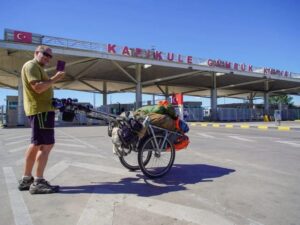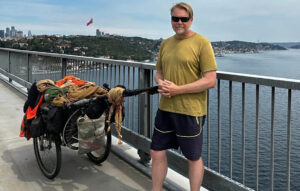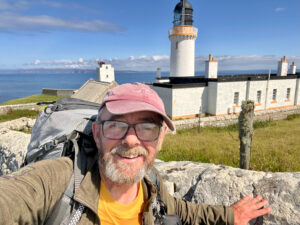Since Captain Matthew Webb became the first person to swim the English Channel in 1875, marathon swimming has fascinated the public. Swimmers are constantly trying to break records and boundaries, and to find swims that have never been completed before. A marathon swim is classed as any open water swim over 10km, in which traditional channel swimming rules apply. Notably, no wetsuits can be worn, just a normal swimsuit, goggles and a thin swim cap. Enduring the cold is considered part of marathon swimming, just as surviving the heat is part of events such as the Hawaiian Ironman.
Long swims test mental strength and willpower as well as physical endurance. Those crazy enough to take on some of the world’s most difficult swims have to be prepared for icy water, nausea-inducing waves, countercurrents and dangerous wildlife.
So in no particular order, here is my list of the worlds hardest open water swims:
1. Farallon Islands to the Golden Gate Bridge

Photo: Kim Chambers
Difficulties: Temperature, sharks, swells
The fog-shrouded Farallon Islands lie 50km across from San Francisco’s famed Golden Gate Bridge. Reaching these islands even by boat takes hours. Nineteenth-century mariners named them the “devil’s teeth” because of their sawtooth profile and treacherous shoals. In 1969, they were designated a National Wildlife Refuge because five species of marine mammal breed there.
The swim officially begins at the Southeast Farallon Island. From here, you must battle ocean swells, powerful currents, water temperatures of 10-15°C and sometimes great white sharks.
Only five swimmers have completed the swim to date: Stewart Evans and the legendary Ted Erikson in 1967 (above clip), Craig Lenning and Joseph Locke in 2014 and Kim Chambers in 2015. This swim is known to be so hard that when Kim Chambers spoke about it afterwards she said she had “prepared not to come back”.
- Straits of Florida

Face puffed from salt and jellyfish stings, Diana Nyad steps ashore at Key West on September 2, 2013, becoming the first person to swim from Cuba to Florida without a shark cage.
Difficulties: Distance, jellyfish, sharks
This has been the site of many marathon attempts since 1950, and one where swimming in a shark cage is recommended. This formidable 150km swim starts in Havana, ends in Key West and involves swimming continuously for well over 24 hours, in strong currents and in the company of jellyfish and sharks. In 2013, Diana Nyad, aged 64, became the first and only person to complete the swim without a shark cage. It took the former professional marathon swimmer and television sports journalist 53 hours and five attempts before she succeeded.
Diana Nyad was one of the world’s greatest long distance swimmers in the 1970s. Her long list of sporting accomplishments included a record-breaking swim around Manhattan. But the Straits of Florida was the white whale that obsessed her. During her first attempt in 1978, at age 28, she swam for almost 42 hours inside a shark cage before doctors removed her from the water. The strong winds and huge swells kept slamming her into the walls of the cage. In her following attempts (twice in 2011, and once in 2012) she swam without a cage and instead used electronic shark shields. Her second attempt failed after she was pushed off course and her asthma flared up. On her third try, Portuguese man o’ war stings led to respiratory distress. And her fourth failed because of two storms and potentially fatal box jellyfish stings.
- Amazon River

Martin Strel in the Amazon River.
Difficulties: Infection, pirates, parasitic fish, piranhas
In 2007, Martin Strel of Slovenia became the first and only person to swim the entire length of the Amazon River: 5,268km from Peru to Belém, Brazil in 66 days. By the time he finished, his blood pressure was so high that it could have easily led to a heart attack, and his body was full of parasitic larvae.
This swim has almost too many obstacles to count. Malaria, dengue and a variety of other infections plague this jungle environment. Venomous snakes, piranhas and bull sharks occur frequently in the river. Piranhas were deemed such a threat that Strel’s safety team had buckets of blood ready to distract them if required. Candiru, a freshwater fish thin as a pencil lead, is said to lodge in the urethras of bathers, then erect its spines, making it impossible to extract without surgery. (Only one such case, however, has been verified.) Nevertheless, unlike the other swims on this list, this did require a wetsuit, in the interests of self-preservation.
Last but not least, pirates do hold sway over parts of the Amazon. Strel and his team used local guides to make sure they went through certain territories unnoticed.
Strel was the first person to swim from Europe to Africa and is the only person to have swum five of the greatest rivers on earth: the Yangtze, Parana, Mississippi, Danube and the Amazon.
Editor’s note: When we mentioned Strel in a past story, one of ExWeb’s correspondents, Piotr Chmielinski, wondered whether an average swimming distance of 80km/day is possible on the Amazon, even with help from the current. Chmielinski knows the Amazon. In 1985-6, he became the first to paddle the entire length of the river by raft and kayak. He wrote:
“Let’s do some math: 5268 km per 66 days = 79.81 km/day. Say 80 km/day. Now, in the 2016 Rio Olympics, gold medalist Ferry Weertman needed 1hr 52min to cover 10 km. To simplify, let’s assume Ferry needed 1hr per 5km. At that pace, the Olympian would have needed 16 hours to cover 80km, and would have to do that each day for 66 days in a row.
On the Amazon, current helps noticeably only in certain areas, mainly the upper parts, such as Atalaya (Strel’s starting point). By Manaus, the current is very slow, and even negative for 12 hrs a day (during ebb tide) after Santarem.
Most Amazon kayaking expeditions take about three months to paddle from Atalaya to the Atlantic, and kayaks are faster than swimmers.
As with many other records these days, nobody has checked Strel’s claims. This is only my five cents.”
- The North Channel

Tom Blower, decorated WWII hero, became the first Briton to swim the North Channel in 1947.
Difficulties: Temperature, jellyfish
From Northern Ireland to Scotland, this 34km swim features cold temperatures (10-12°C), extreme currents and hundreds of Lion’s Mane jellyfish that are almost unavoidable. After completing the swim in 2014, Adam Walker said of them, “I was not prepared for how big they can be.”
This swim (along with some others on the list) is part of the Oceans Seven, a set of open-water swims considered the equivalent of the Seven Summits in mountaineering. Adam Walker was the first British man to complete all seven, and the North Channel was the final one on his list. Mainly because of the cold, only 34 people have ever completed this swim. The first was Tom Blower in 1947. It took another 23 years before the second crossing.
- Kaiwi Channel

Adam Walker had to pull a Portuguese man o’ war off himself with three hours left.
Difficulties: Currents, jellyfish, sharks
Also known as the Molokai Channel, Kaiwi separates the Hawaiian Islands of Oahu and Molokai. The water is extremely deep (up to 701m), which leads to aggressive currents and relentless white caps. The 42km swim is also littered with marine life, most notably tiger sharks and Portuguese man o’ war. Only 50 people have finished the swim, despite frequent attempts. When British swimmer Adam Walker completed it as part of his Oceans Seven quest in 2012, a Portuguese Man O’War sting made him lose feeling in his spine.
- Tsugaru Channel

David Yudovin.
Difficulties: marine life, currents
This is the least known of the Oceans Seven and the shortest one on this list at only 19km, but don’t let that fool you. The Tsugaru Channel, which separates Japan’s two largest islands, Honshu and Hokkaido, has rough currents, sharks, sea snakes and jellyfish. Swimmers take one of two routes: Kodomari or Tappi Misaki. The Kodomari route is slightly longer but offers slightly less risk and has a higher success rate. Only 26 people have completed the swim. The first was prolific marathoner David Yudovin in 1990.
Yudovin became known for pioneering channel-swimming firsts around the globe. He completed 45 solo marathons and over 15 of these were firsts. In 2015, the World Open Water Swimming Association named him one of the Greatest Watermen in Open Water Swimming History.






